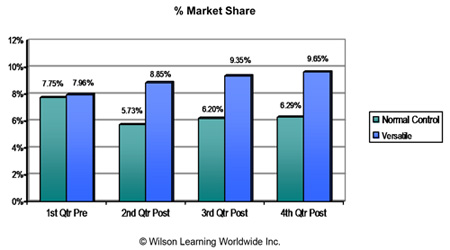Versatility
The Key to Sales Performance
Executive Summary
While having a salesforce that can deliver your company's message to the marketplace is critical to effective performance, the true key to success is having a salesforce that can adapt that message to the needs and preferences of the customer. Our research shows that versatile salespeople can be over 50% more successful than their less adaptable counterparts.
This was effectively demonstrated in a study done in the highly competitive pharmaceutical industry. Development of sales versatility skills had a significant impact on a key strategic driver-product market share. When compared to salespeople who did not receive versatility skills training, the versatile salespeople's market share was significantly higher and continued to improve every month of the yearlong study.
Helping salespeople learn how to recognize their customers' preferences and styles, and to adapt their sales strategy to more directly meet those preferences, has proven to be the key to sales performance.
What is Sales Versatility?
There are two things almost all salespeople know:
- All things being equal, we really only "connect" with about 25% of our customers.
- It is easier to sell to those customers with whom we "connect."
When people say they "connect" with someone, they are referring to the similarity of their communication preferences and styles. We feel more comfortable with people who like to talk at the same pace we do—who are not too pushy or too pliable and who want to get to know about us at about the same time we are ready to share that kind of information.
Decades of research indicates that people are divided equally across four primary communication styles. We call these the four Social Styles: Driver, Expressive, Amiable, and Analytical. When a customer is easy to work with, it is often because you and the customer have the same Social Style. When a customer seems difficult to work with, it is because your styles are different.
Because each style represents about 25% of all customers, most salespeople only share Social Styles with one out of every four customers, and a majority of their sales will tend to come from those customers. But what if salespeople could learn to "connect" with the other 75% of their customers? Would they be able to sell more effectively to those customers as well?
These were the key questions asked by Wilson Learning and a large U.S.-based pharmaceutical company. This study shows that by teaching salespeople their preferred style of communicating, how to recognize the styles of their customers, and, most importantly, how to adapt their style, salespeople connect with a broader base of customers and their performance goes up.
The Study
The Performance Measures
The first step was to determine what performance to measure. To prove the impact of versatility skills on the company, a strategically important performance metric was needed—not just a change in perception or attitude, but a real bottom-line outcome.
For this study, the company chose to measure market share of their two most important product lines. These two product lines have a very large market and a large number of strong competitors. Because of the market size, even a modest increase in market share would be worth millions of dollars in revenue. And, because of the strong competition, just holding on to current market share was a difficult task. For this company, if more versatile salespeople could increase market share, it would be more than worth the expense and effort.
The Salespeople
We selected a region of 40 salespeople to test our ideas. This was a group of already highly successful salespeople. In order to prove that sales versatility was the cause of an improvement in market share, we divided this group into two subgroups:
- Normal Control group: These salespeople received the normal training typically provided to salespeople (more traditional sales skills, product training, etc.).
- Versatile Salesperson group: These salespeople received, in addition to the normal training, specialized skills in how to identify a customer's Social Style and how to be versatile in their sales approach based upon Social Style.
Short-Term or Long-Term Effect?
Improving sales versatility would not have much value if performance improved for only a few months and then diminished. This is the fate of many training programs—once the initial "shot" wears off, the improvement goes away. So, for this study we collected the market share performance data not just for three months following the training, but for a full nine months following the training.
There were two groups of salespeople; one was given sales versatility training, the other was not. Market share information for two key product lines was collected just before training and then for each of the next three quarters (nine months) after the training. Without the normal control and the long-term performance data, there are a number of things that could have explained the performance increase. So, by studying sales versatility in this way, we now have proof that the versatility skills were the cause of any increase in market share.
Findings
 Results of this study provide convincing evidence that versatility skills caused a significant increase in market share. The following graph summarizes the market share changes and can be used to answer a number of questions.
Results of this study provide convincing evidence that versatility skills caused a significant increase in market share. The following graph summarizes the market share changes and can be used to answer a number of questions.
Were the groups really equal to start?
There was always the possibility that the versatile salesperson group was better to begin with, so we measured market share for the three months just before the training. As the graph shows, the two groups had virtually the same performance, 7.75% and 7.96%. Therefore, any change in market share after the training is not due to differences before the training.
Did performance improve after versatility training?
There was a profound improvement for the versatile salespeople over the normal control group in the first quarter after the training. As the chart shows, the normal control salespeople actually lost market share, down 26%. This was in part due to the introduction of a new product by a competitor. But, for the versatile salespeople, not only did they avoid the market share drop, they actually increased market share by 11%, despite the new competitive product on the market.
Thus, when you compare the versatile salesperson group to the normal control group, the versatile salesperson group's market share was 54% higher than the normal control group's after the first three months. But improvement did not stop there.
Was the performance improvement sustained over time?
Market share continued to climb for the versatile salespeople across all nine months of the study. After the 11% improvement in the first quarter, market share in the second quarter was up more than 17% from the pre-training period, and up 21% in the third quarter.
The normal control group regained some of the market share they lost, but not much—they ended down 19%. This means that when you compare the versatile salesperson group to the normal control group, versatility skills produced a 53% improvement in market share.
Conclusion
What is a 53% improvement in market share worth to your organization?
As described at the beginning of this article, because of the large market for these products, this kind of improvement was worth a great deal. We cannot tell you exactly how much as it might expose proprietary information. This is against a cost of two days of training for each salesperson and manager.
Put in another way, if an organization with 6.29% market share has 1,000 customers, each purchasing $1,000 in product, then each one percent increase in market share is worth $158,982. So an improvement from a 6.29% market share to a 9.65% market share (or 3.36%) is equal to $534,179 in increased revenue. Of course, your results will depend upon your current market, market share, and customer revenue. But, for this pharmaceutical firm, creating versatile salespeople was a highly profitable return on investment.
And the ROI did not end there. Performance continued to increase over the entire time we tracked it, and most likely well beyond. Thus, this is a sustained improvement. As salespeople apply their versatility skills, they perform better and better. So one year, two years, or more after training, sales versatility is still increasing your company's performance and profitability.







 Please complete this form to download Versatility | The Key to Sales Performance.
Please complete this form to download Versatility | The Key to Sales Performance.



